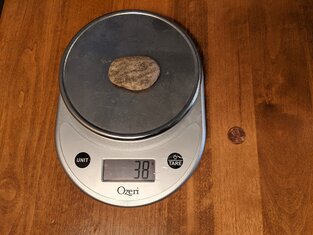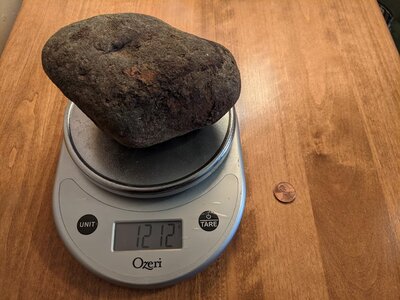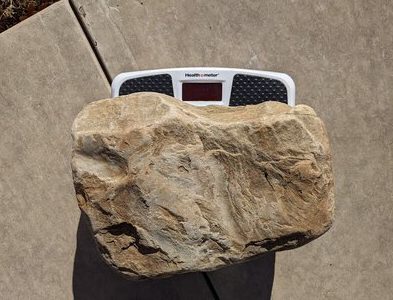
Asking how much a rock weighs is an interesting question because the answer is, of course, going to depend entirely on the specific rock you’re asking about. I wanted to write this article to give a definitive answer to a question that is more complicated than it might seem on the surface. If you’re curious about how much a rock weighs – regardless of the size or type of rock you’re wondering about – you’ve come to the right place.
On average, a cubic foot of rock weighs 165.2 pounds, but depending on the type of rock it may weigh between 143.6 and 186.0 pounds. A rock’s weight is determined by its density and volume. An approximation of any rock’s weight can be calculated using simple volumetric formulas.
Rock Weight By Size
If you’re trying to get an approximate weight for a rock of a particular size, I’ve taken care of that work for you here. I went out and found rocks of a bunch of common sizes and weighed them for you (with the exception of very large sizes), and measured their diameters so that you can make more direct comparisons to the type of rock you’re wondering about.
Keep in mind that the exact weight of your rock will certainly vary a bit compared to the rocks I weighed, but you should be able to get a very good idea by comparing them to this chart and the pictures below. The exact weight of a rock will depend on its size and density. I have included pictures of each of the rocks I weighed for reference.
| Rock Size | Diameter | Weight (Imperial) | Weight (Metric) |
|---|---|---|---|
| Pebble | .5 in | .035 ounces | 1 g |
| Landscaping Rock | 1.25 in | 1.41 ounces | 40 g |
| Skipping Stone | 1.6 in | 1.41 ounces | 40 g |
| Cobble | 4.5 in | 2.6 pounds | 1.2 kg |
| Basketball sized | 9.5 in | 42 pounds | 19 kg |
| Yoga ball sized | ~26 in | ~920 pounds | ~418 kg |
| Car sized | ~10 ft | ~86,500 pounds | ~39,271 kg |
| Bag of Landscaping Rocks | — | 50 pounds | 22.7 kg |
| Pallet of Landscaping Rocks (50 bags) | — | 2,500 pounds | 1,136 kg |
Pebble
After measuring several pebbles of different sizes, I determined that the average weight of a pebble is about 1 gram (.035 ounces). The weights of the pebbles ranged from .1 grams to 3 grams (.0035 ounces to .106 ounces). Anything larger than that I wouldn’t personally call a pebble anymore. See the pictures below for reference.


Landscaping Rocks
I went outside to the landscaped area of my yard and selected a representative rock. I laid these marble chip rocks myself a few years ago so I good a good sense of how much they weigh when bagged up and in a wheelbarrow! A landscaping rock weighs about 40 grams, or 1.4 ounces. There are many different sizes and types of landscaping rocks, of course, but you can see the images below for reference.


Skipping Stone
Obviously there is quite a bit of variation in the size of skipping stones, but I found what I would consider to be an average sized rock that I’d use for skipping and weighed it on my food scale. A skipping stone weighs about weighs about 40 grams, or 1.4 ounces.

Cobble
Now we’re getting into some decent sized rocks. The rock I chose is about the size you’d see used in a cobble street. It’s a bit bigger than my closed fist. This size rock is about the biggest sized rock I’d throw – anything larger than this would be impractical. A cobble sized rock weighs about 2.6 pounds, or 1.2 kgs.

Basketball Sized Rock
I had to change scales to measure this rock. Just about anyone can carry a rock this size, but it will start getting heavy for some people. I took a trip out to my parents’ place to choose between a bunch of large landscaping rocks and tried to find the one that looked closest to basketball-sized. A basketball-sized rock weighs about 42 pounds, or 19 kgs.

Yoga Ball Sized Rock
At this point, the rocks became too large to carry or weigh on a scale, so I had to switch to some mathematical calculations and approximations instead. A yoga ball is about 26 inches in diameter, so using an average rock density of 165 pounds per cubic foot I calculate that a yoga ball-sized rock weights about 920 pounds, or 418 kg.
Car Sized Rock
We’re getting into some rough estimates here, but I wanted to calculate a good approximation for a very large boulder. I decided on a rock that is roughly the size of a car. Assuming a diameter of 10 feet and an average density of 165 pounds per cubic foot, a car-sized boulder weights about 86,500 pounds, or 39,271 kg.
Bags of Landscaping Rocks
I happened to have a few extra bags of landscaping rocks laying around from a previous home improvement project, so I decided to weigh those and add them to the list. A bag of landscaping rocks weighs 50 pounds. One of these bags is easily moved by someone in reasonable shape, but speaking from personal experience it can quickly become exhausting if you’re moving a lot of bags.
A pallet of landscaping rocks usually contains about 50 bags, which comes out to 2,500 pounds. I loaded up every nook and cranny of my mid-sized SUV with about that many bags from a home improvement store and it was definitely struggling. Note that these weights will likely change significantly if the bags have been rained on and retained any moisture.
Rock Weight by Type
If you’re wondering how much a specific type of rock weighs, please see the table below. It will cover the most common rock types, and if you can’t find exactly what you’re looking for then chances are there is a very close substitute listed.
For the purposes of this table, I used a theoretical cubic rock that measures 1 foot in each direction. I list the average densities of each rock type in g/cm3 because that is the most commonly used unit for this measurement. Note that the listed densities are what is referred to as bulk density, which is the mass of the rock per unit of bulk volume including the pore space. This is in contrast to particle density which does not include pore space.
| Rock Type | Size | Density (g/cm3) | Weight (lbs) | Weight (kg) |
|---|---|---|---|---|
| Sandstone | 1 ft3 | 2.30 | 143.6 | 65.2 |
| Limestone | 1 ft3 | 2.70 | 168.6 | 76.5 |
| Shale | 1 ft3 | 2.35 | 146.7 | 66.6 |
| Dolomite | 1 ft3 | 2.60 | 162.6 | 73.8 |
| Granite | 1 ft3 | 2.63 | 164.1 | 74.5 |
| Marble | 1 ft3 | 2.71 | 169.1 | 76.8 |
| Basalt | 1 ft3 | 2.90 | 181.0 | 82.2 |
| Quartzite | 1 ft3 | 2.65 | 165.4 | 75.1 |
| Gabbro | 1 ft3 | 2.98 | 186.0 | 84.4 |
According to these calculations, a cubic foot of rock weighs, on average, 165.2 pounds. Depending on the type of rock it may weigh between 143.6 and 186.0 pounds. Unusually light or heavy rocks may fall outside of this range.
Weights of Famous Rocks & Lifting Stones
It may come as a surprise to many people, but there are many famous rocks that people enjoy lifting because of their history and the challenge they present. People from all over the world travel to countries like Scotland and Iceland to lift these famous lifting stones.
I myself made it a point to seek out a lifting stone while on a recent trip to Scotland. I’m a competitive powerlifter, so it offered a unique opportunity to combine two passions of mine – rocks, and lifting heavy things!

Below is a table that lists some of the most famous lifting stones in the world and how much they weigh. Each one of these rocks has a unique history behind it. If this is something that interests you I’d highly recommend this documentary on YouTube that goes into the history of lifting stones in Scotland.
| Stone Name | Weight (lbs) | Weight (kg) | Location |
|---|---|---|---|
| Dinnie Stones | 733 | 332 | Potarch, Scotland |
| Inver Stone | 260 | 118 | Inver, Scotland |
| Barevan Stone | 231 | 105 | Cawdor, Scotland |
| Newtonmore Stone | 240 | 109 | Newtonmore, Scotland |
| Dalwhinnie Stone | 224 | 102 | Dalwhinnie, Scotland |
| Fianna Stone | 300 | 136 | Glen Lyon, Scotland |
| Chieftain’s Stone | 250 | 113 | Castle Menzies, Scotland |
| Ardvorlich Stone | 334 | 152 | Ardvorlich, Scotland |
| Puterach Stone | 230 | 105 | Glen Balquidder, Scotland |
| Dripping Cave Stone | 286 | 130 | Cromarty, Scotland |
| Húsafell Stone | 409 | 186 | Húsafell, Iceland |
| Leggstein | 484 | 220 | Heydalur, Iceland |
| Judas Stone | 280 | 127 | Látrabjarg, Iceland |
How To Calculate & Approximate The Weight of Rocks
Just in case the measurements and tables I listed above didn’t cut it for you, now I’ll go into how to measure and approximate the weight of whatever rock you’re wondering about. With just one or two simple measurements, by following these instructions you’ll be able to calculate how much your rock weights with a fair degree of accuracy.
Of course, the easiest and most reliable way to find out how much a rock weighs is to put it on a scale (or carry it on to a scale with you). Unfortunately, that’s not always an option because you might not have a scale available or the rock may simply be too big.
The weight of any rock depends on two things: density and volume. If you can measure or approximate these two values then you can easily calculate a good approximation of how much a rock weighs.
- Determine rock type and density
- Measure the rock’s dimensions
- Calculate the weight of the rock
Determine Rock Type and Density
The first thing you’ll need to calculate the weight of a rock is its density. Luckily for us, people have devoted their entire careers to studying rocks (myself included) and determining their physical properties – including density.
If you know what kind of rock you’re dealing with then all you need to do is consult a table like the one I created earlier in the article that tells you the density of that type of rock. If you don’t know what type of rock it is, you can use an approximation of 2.7 g/cm3.
Measure the Rock’s Dimensions
The next thing you’ll need to do is measure the dimensions of your rock in order to calculate the volume. The measurements you’ll need and the formula you use will depend on the approximate shape of your rock. Remember that most density measurements you’ll find for rocks will be listed in g/cm3, so I’d recommend making your measurements in centimeters.
If your rock is roughly spherical in shape then you’ll just need to measure the circumference. If it’s a little oblong or irregular, just find a cross-section that looks representative of the size of the rock and measure at that point. Then use the formula V=C3/(6π2)
If your rock is more rectangular or cube-shaped then just measure its approximate height, width, and length and multiply them together. If you’ve forgotten your geometry lessons, use the formula V=h*w*l.
If you can’t directly measure the rock in question (maybe you’re just wondering about a big rock in the distance) then try to make a rough approximation by just eyeballing it. Use the same formulas I listed above to get a rough estimate of the rock’s volume.
Calculate the Weight of the Rock
You now have everything you need to calculate the weight of your rock. Since you have good measurements or approximations of the density and volume of the rock, the calculation for weight is simply:
Weight = Density*Volume
If you performed all of these calculations in cubic centimeters and grams, then the result of this calculation will be in grams. To convert grams to pounds, just multiple your result by .0022 and you’re all done!
Related Questions
How big is a 1 ton rock? Assuming an average weight of 165 pounds per cubic foot, a 1 ton rock has a volume of 12.1 cubic feet, a diameter of 2.85 feet, and a circumference of 9 feet.
Why are rocks so heavy? Rocks are heavy because they are very dense when compared to most other common materials. With an average density of 2.7 g/cm3, they are much denser than wood (~.6 g/cm3) or water (1 g/cm3). Rocks are so dense because they are generally comprised of tightly packed, relatively heavy minerals.
How much does a 5-gallon bucket of rocks weigh? – A 5-gallon bucket of rocks weighs about 67 pounds.
How much does Dwayne ‘The Rock’ Johnson weigh? According to wikibio, The Rock weighs 262 pounds.
